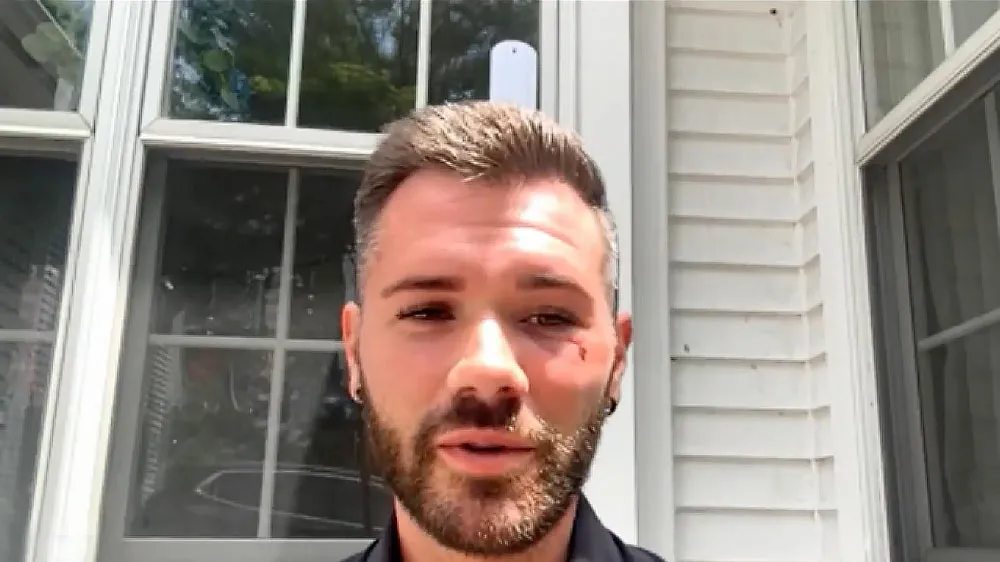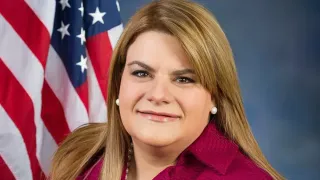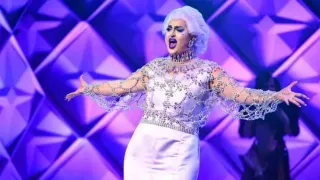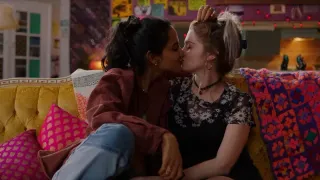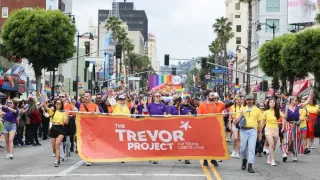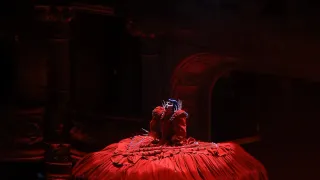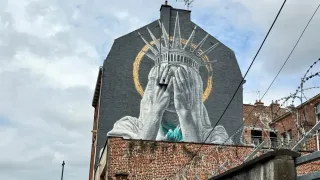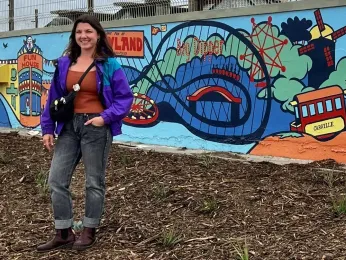
Jun 24
City streetscapes inspire artist Fromm
Matthew S. Bajko READ TIME: 7 MIN.
An amusement park and saltwater swimming pool complex that once drew San Franciscans to Ocean Beach can be seen again along the city’s Pacific Ocean shoreline. Artist Emily Fromm drew inspiration from Playland-at-the-Beach and Sutro Baths for their mural titled “A History of Play.”
The civic booster group for the city’s newest park, Sunset Dunes, had reached out to Fromm last November about painting the mural on the backside wall of a building along the Great Highway with public restrooms that face the N-Judah subway line’s terminus at Judah and La Playa streets. Fromm incorporated images of the Sutro bathhouse’s entrance and Playland’s Big Dipper rollercoaster into the work, along with children skateboarding, surfers headed to the beach, and a person flying a kite.
“Other artists did ocean themes, I went the history route,” Fromm, 33, told the Bay Area Reporter this spring.
The mural by Fromm, who is nonbinary, is one of a number of art installations visitors to the park will find. Sunset Dunes officially opened to the public in April following voters’ approval last November of Proposition K, the ballot measure that closed the Great Highway that spans Ocean Beach and turned its traffic lanes into a recreational promenade.
Its passage was controversial, with an overwhelming majority of nearby residents voting against Prop K. It also spawned the recall effort against gay District 4 Supervisor Joel Engardio, with Sunset District voters set to decide his political fate on September 16.
The animosity churned up by the closure of the roadway, for decades a convenient route for commuters in the city’s westernmost neighborhoods, has manifested into vandalism of several of the art installations at the park. This month, a piano was smashed and a phone booth that allowed people to “call” their deceased loved ones was damaged.
Back in March, as Fromm worked on their mural, they were subjected to angry outbursts of passersby. People opposed to the park would yell at Fromm and get into arguments with other people walking by about the merits of the street closure, which occurred on March 12.
“The day it closed, the vibe was off,” recalled Fromm. “People came up saying not nice things and that they don’t want the mural.”
Overnight, someone tagged Fromm’s mural with white paint in a zigzag pattern. Since it wasn’t finished, Fromm had yet to put a protective seal on it that would have made repairing it easier. Instead, they needed to completely redo it.
“I cried,” said Fromm, at the thought of taking another month to restore it.
After composing themself, Fromm decided to put out a call for help. More than 100 people turned up over three days to assist in repainting the mural, which was sealed on March 21 so it can be pressure washed if ever tagged again.
“I essentially finished it right on time,” said Fromm.
The vandalism and subsequent public support brought a wealth of media attention to Fromm and the mural. It is now one of their best-known works, and the publicity has generated interest from companies and individuals seeking to have Fromm create murals at their worksites or private homes.
“I am grateful to have the chance to bring my art to the world,” said Fromm over lunch at Java Beach Cafe, which is across La Playa from the site of their beach mural and also has artwork by Fromm on its walls. (Its location on Sloat Boulevard by the San Francisco Zoo features a mural of a cityscape on its facade done by Fromm in 2022.)
Having lived near Ocean Beach for 13 years, Fromm told the B.A.R. they would have voted for Prop K were they still a San Francisco resident. On Halloween 2022, Fromm and their husband, Jimmy Rogers, received the keys to the home they bought in the oceanside town of Montara in San Mateo County where they live with their grey tabby Moze, now 8. Fromm set up an art studio in the garage, which has a small kiln for the ceramics they make, and can gaze out on the green slopes of Montara Mountain.
The couple first met while riding the L-Taraval subway line 12 years ago; they struck up a conversation and soon were living together in the city’s Sunset district. Today, at the line’s West Portal Station stop, passengers are greeted by welcoming and wayfinding murals on either side designed by San Francisco Public Works and painted by Fromm.
(In 2021, Fromm had painted a mural on a temporary boarding platform erected near the station on Uloa Street that depicted the area’s commercial corridor. Pictures of it can be seen on Fromm’s website .)
Inspiration from pop art
Fromm draws inspiration from pop art, comic books, and the Mission School of artists that came up in San Francisco in the 1990s and 2000s, whose works will be featured in the show called “Bay Area Then” opening at Yerba Buena Center for the Arts August 1. Moth Belly Gallery co-owner KT Seibert describes Fromm’s style as “clean graphics but with a sort of… just a playfulness and whimsical nature to it. It is very approachable and beautiful.”
Seibert, 37, who is queer, nonbinary, and transgender, got to know Fromm well in 2020 when they rented a studio space in the basement of the Larkin Street gallery in San Francisco’s Polk Gulch neighborhood. Now best friends, Seibert is featured sitting on a bench with a racoon perched atop it in a mural Fromm did in 2022 for Google Inc.’s Bay View Campus at the Nasa Ames Research Center in Mountain View, California. It faces the mural that Seibert was also commissioned by the tech company to do.
“Emily is one of my favorite people,” said Seibert, adding that Fromm is “just so warm and kind, and just has been such a great addition to the art community.”
Raised in Santa Clarita in Southern California, Fromm moved to San Francisco to attend San Francisco State University, graduating in 2013 with a BFA in paintings and ceramics. (They enrolled as a language major but then convinced the dean overseeing the arts school to allow them to switch majors.)
“Painting has been my first language since I was a little kid, more than drawing or writing, I would say,” said Fromm, whose “happy place” as a child was their apartment balcony where their Fisher Price easel would be set up for them to paint. “I was communicating in pictures.”
Milk terminal project
A decade ago, Fromm had been accepted into the artists pool overseen by the San Francisco Arts Commission, allowing them to apply for civic art projects. They were a finalist for several but weren’t selected until tapped in 2017 for one of the public art projects available in the redesigned Harvey Milk Terminal 1 at San Francisco International Airport.
“I was thrilled. It was a huge project to be brought to my attention as my first public gig,” said Fromm, who happened to be riding a Muni subway car in the Sunset when they fielded the call. “I had no idea what I was going to do.”
The material they chose to work with had to be permanent, so paint was off the table. They opted to do a tile mosaic mural and submitted six sketches inspired by different neighborhoods around San Francisco. The one of the city’s LGBTQ Castro district, which the terminal’s gay namesake had called home and represented as its supervisor, depicted the 400 block of Castro Street with the facades of gay bar Twin Peaks, baked goods shop Hot Cookie, and the Castro Theatre.
Called “Four Corners,” the 40 feet by 10 feet mural features four panels, with Chinatown, the Mission, and the Embarcadero neighborhoods also depicted. Installed near a boarding gate seating area, it debuted to the public on May 25, 2021.
“My hope is people who have never been to San Francisco get to see this snapshot of the city, and for people who call it home and know it well, that these images will resonate with them,” said Fromm, who has had friends and others tell them seeing the mural when returning from a trip “feels like it welcomes them home.”
Using hundreds of photos they had taken, 50 alone of the Castro, Fromm drew scenes of urban life with pen and ink then made digital renderings of them in Photoshop. They hired an architect to help them create a mock up to present to the arts commissioners for approval.
“I never stepped foot into the terminal,” recalled Fromm, who at the time was working part-time for a company that shipped items people won at nonprofit gala auctions.
The commission ended up totaling $400,000 and provided $40,000 in take home pay for Fromm. The murals are made from a material called byzantine mosaic smalti and were fabricated by Mosaika Art & Design located in Montreal, Canada, which Fromm visited multiple times to meet with the team of 20 people working on their mural.
“It broke me. I was not expecting this to happen, but I was so excited and so amazed, I felt recognized and validated but also I was really unprepared,” recalled Fromm, who back then also worked at bars and coffeeshops. “I felt a lot of impostor syndrome. Who am I to have this big job? At the same time, I wanted to do it right.”
Unbeknownst to Fromm at the time, who suffered panic attacks designing the airport installation, they have bipolar disorder. Looking back at the time of their life now, it feels like a dream, said Fromm.
“It broke my mind open in a good way. All these possibilities were there,” they said.
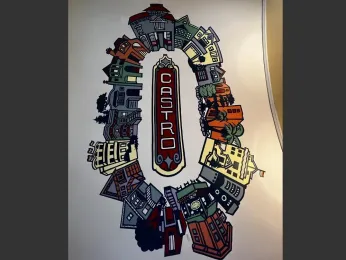
Physically demanding
Since 2018, Fromm has worked as a full-time artist but continues to teach Pilates and barre classes at SF State and the YMCA. The exercise is good for their back, Fromm noted, as they spend upward of six hours standing on a ladder when installing their murals.
“I love making murals and want to do them as long as I can. But it is physically demanding, and when I am 65, it is not going to get any easier,” said Fromm.
While the global health crisis five years ago put a crimp on the public and corporate commissions Fromm could apply for, it brought them an increase of requests from private homeowners looking to beautify their home interiors that were now doubling as office spaces. Fromm also sells their paintings via their website .
“It was slow, for sure. 2020 was a rough year,” recalled Fromm.
Three years ago, Gary Jaffe, who is straight, engaged Fromm to paint a mural on the living room ceiling of his Corona Heights home he has lived in since 1987. Fromm drew inspiration from snapshots of nearby residences, incorporating their facades and that of Jaffe’s house into a circular composite with the neon “Castro” sign for the Castro Theatre in the middle.
“It is fantastic,” said Jaffe, 82, a retired management consultant and avid art collector. “I had a big party celebrating the finishing of the mural. People loved it; I thought it was fantastic because not a lot of people have a mural in their home.”
He also has several prints of Fromm’s drawings hung up in other rooms of his home. In 2020, at the start of the COVID pandemic, Fromm happened to be the instructor of an online Pilates class that Jaffe took. He then saw her murals inside the Milk terminal and inquired if Fromm would be able to install one in his home.
“It was a challenge because it is curved,” he noted of the ceiling, which took Fromm nearly three weeks standing on a step ladder to paint.
Showing it off to a reporter, Jaffe said he is drawn to Fromm’s use of color in their works; they used a palette of red, orange, yellow, gray, purple, blue, and green paints for his mural. He likened Fromm’s aesthetic to that of old-style cartoons but photo realistic, adding that their “ability to take a photo and translate it into a beautiful work of art really appealed to me.”
Seibert said Fromm’s technique creates an “ideal dreamlike quality” to the cityscapes and urban settings they depict in their work. Viewers can tell Fromm loves San Francisco from how they portray it, noted Seibert, adding that Fromm’s simplified color palettes draw people to their artwork.
“I think they have a way of capturing a very simple beauty of city life, especially a city that has a reputation for being a little gritty at times,” said Seibert, praising Fromm for having a “really good eye for composition” that results in “a magical realism. Emily includes a lot of elements into one scene but it still looks cohesive.”
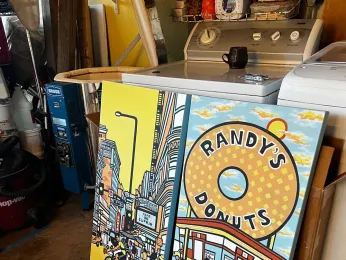
Freedom in the world
Much of their artwork is rooted in experiencing freedom in the world, said Fromm. Moving to San Francisco provided that in their own life.
“It is a beacon, a sanctuary city, a global symbol of acceptance for this community and has been for so long. Right now, there is an artist revival in places like the Tenderloin where artists can get a toehold and be able to stay. It is awesome,” Fromm told the B.A.R.
In 2023, Fromm first told their husband they were nonbinary and began toggling between using she and they pronouns. Most people who know them well weren’t surprised by the news.
“Having some fluidity to how I look at myself feels more honest,” said Fromm.
Growing up, they were more apt to be playing in the dirt than with dolls but appeared as a “girly girl” who wore makeup and loved the color purple. Their parents never questioned it, recalled Fromm, who joined the Gay Straight Alliance at school but didn’t know how to describe their gender identity at the time. Fromm likened hearing nonbinary for the first time to discovering the name for a new color.
“It took a while to have the right word. Nonbinary was not used then,” said Fromm. “I still liked men but was feeling differently than female.”
Last July 14, which is observed each year as International Non-Binary People's Day, Fromm came out publicly as nonbinary in a post on their Instagram page.
“This is not about correcting people or policing language, as I hope to be hard to offend and quick to forgive. So whatever you like to call me: dude, duder, el duderino, bro, sis, big dog, lil mama, beard papa, E money Fre$h, or, of course, Emily, please do what feels right,” wrote Fromm. “I’m here for all of it and love you guys. I just wanted you to know. PS sorry for never going to pride. I fear parades. But I hope you all had so much fun.”
They plan to attend their first Pride celebration this Friday, as Fromm is set to join Seibert at the Trans March in San Francisco.
“I am really excited for that,” Fromm said.
